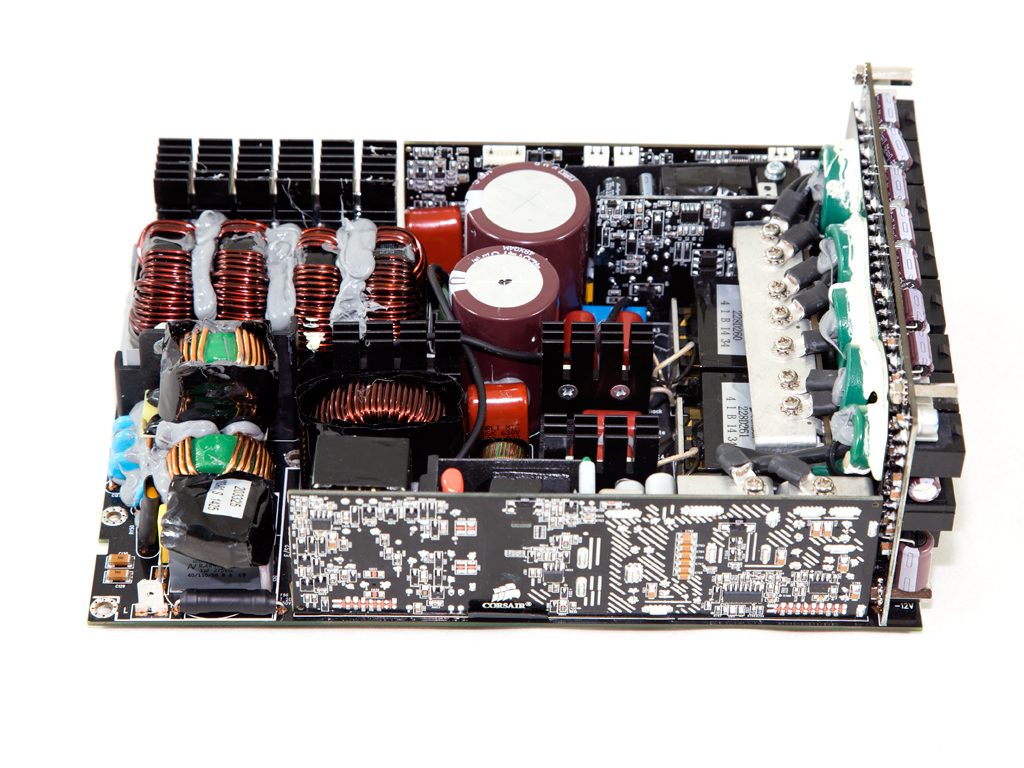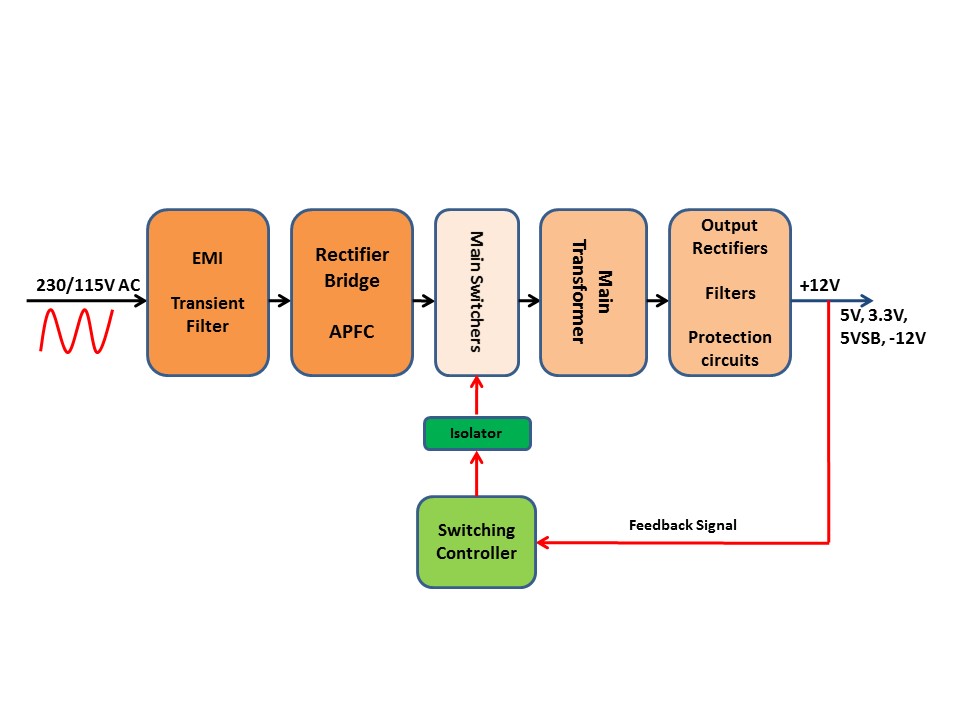Picking The Right Power Supply: What You Should Know
How does a power supply work? Why is it important to choose a sufficiently powerful and efficient model? We guide you through discussions of efficiency and tips for getting the best deal before we go on to explain why less can be more in the PSU market.
How A Switching Power Supply Works
Why you can trust Tom's Hardware
In this section we will provide a very brief explanation of what happens inside a switching power supply. Again, we strongly advise you to read our PSU 101 article if you want to get a more detailed analysis.
What's Inside, And How Does It Work?
A switching power supply consists of several stages. A filter for the mains power sits right behind the input, filtering out surges, harmonics and various other undesirable phenomena found in the mains power. It also prevents any EMI noise produced by the PSU to affect nearby devices. In the second stage, the AC power stream is rectified and screened by one or more bridge rectifiers. At this point, we’re dealing with about 325V (with 230V input), which are fed to the APFC converter. The APFC’s FETs (usually two) separate the intermediate DC voltage into constant pulse sequences. These pulses are smoothed out by the bulk capacitor(s) and are fed to the main switchers. The latter chop the DC signal coming from the smoothing capacitor into pulses, whose amplitude is the magnitude of the input voltage, while the duty cycle is controlled by a switching regulator controller. Thus, the DC signal is converted to an AC rectangular waveform that is fed to the main transformer. The higher the switching frequency of the primary switches the smaller the size of the main transformer and we have gains also in EMI noise, ripple suppression and transient response. On the other hand, lower switching speeds increase efficiency, though a larger transformer is needed and the EMI noise is increased, ripple suppression is affected and the transient response becomes slower.
Corsair AX1500i’s internals. This is probably the most advanced commercial PSU up to date.
Eventually, differing voltages of 3.3, 5 and 12V are required, which means that simple PC switching power supplies have either a single output rail with different taps for each voltage or separate rails for each voltage. Top-end PSUs even have separate coils for the voltages (if they don’t use an LLC resonant converter since PSUs with these don’t need coils; even if they do exist, they just play a role in the filtering process), which are then corrected and smoothed a second time following transformation. The most important thing is that these voltages have to stay consistent. Regardless of whether the PC is idling or under full load, voltages may not deviate from their spec by more than five percent according to the ATX spec. A regulator circuit ensures this is the case.
That brings us to our next topic: efficiency. If you’re looking for a new car, you’re going to ask your local dealer, “So, how many miles per gallon does this one get?” Now, PSUs may not burn gasoline, but you still have to look out for their efficiency. Indeed, this is one area where most builders unknowingly waste the most power, increasing the PC's cost over its lifetime. Want to make sure you don’t make that mistake? Take a look at the next page!
Current page: How A Switching Power Supply Works
Prev Page Brought To You By Granny’s Radio Next Page Efficiency, Efficiency, Efficiency!Get Tom's Hardware's best news and in-depth reviews, straight to your inbox.

Aris Mpitziopoulos is a contributing editor at Tom's Hardware, covering PSUs.
-
abryant Archived comments are found here: http://www.tomshardware.com/forum/2916-56-picking-power-supply-knowReply -
pjmelect A few more words about active power factor correction. APFC won't save you money on your electric bill although the electric companies will love you for it as it minimizes loss over the power lines saving them money, it does however enable you to use a much lower rated battery backup system. A hypothetical example a computer that uses say 200W without APFC would require a backup system of 700W or much more to cope with the large peaks in current where as a power supply with APFC would require a backup system of 250W or so.Reply
Therefore APFC is only worthwhile if you were to use it with a battery backup system. -
turkey3_scratch Very well written article! Just one thing. You say:Reply
Regardless of whether the PC is idling or under full load, voltages may not deviate from their spec by more than five percent according to the ATX spec.
But the ATX specification seems to disagree. According to the spec, full load or "peak loading" allows 10% deviation from the nominal voltage for the 12V rail.
http://www.formfactors.org/developer/specs/Power_Supply_Design_Guide_Desktop_Platform_Rev_1_2.pdf
Also, Q about the power factor correction. It's probably the most difficult topic to understand. In this case, you say the load would be anything that used power. Are you talking about hardware like a GPU or the internals of the PSU like capacitors and such? Also, say the computer is putting load on the PSU. How is there idle current then? -
jossrik There have been quite a few instances in the past where you could get an XFX PSU 550w or so for 40$ or less with rebates. I know compared to more modern PSUs they may not stack up, but they used to be pretty decent. Ya, more often than not, the cheaper the PSU the worse the quality, but you really do need to do your homework.Reply
Budget PSU
https://www.youtube.com/watch?v=Ezk9OA7aKOE -
Aris_Mp The newest ATX spec defines 5% at peak load as well. The 10% is only for the -12V rail which is now optional. The newest ATX spec is confidential (dont know why)Reply -
cats_Paw While I can understand that having a beefy power supply on idle state wont be too efficient, its on loads where you want it as efficient as possible.Reply
Somehow, having a low efficiency under a 65W load is less expensive than low efficiency at 500W load, go figure :D.
-
cats_Paw In all fairness, a PC is not a self-maintenance Robot.Reply
If you want a PC to last a good 10-15 years you need to take care of it:
Clean dust, replace fans when they fail, replace thermalpaste, check your temperatures from time to time, not turn it on-off-on too fast, keep your Hard drives with some spare space and defraged if they are HDDs....
There is quite some work for a PC to keep their form, but its not like a human can lay down in bed eating cheese and drinking cola looking like a model either.
PSUs however have this strange aura of magic around them since some people vastly overestimate what power supply they need (I got a 700W TT one for a load of 320, go figure) and others buy things that are simply bad products, no matter how high the W are.
I did once burn a PC due to a bad PSU (and I even OCed the damn PC, went down in smoke.. I gotta say it was quite fun, but expensive), so I stay on the safe side (I just simply add an extra 20% for 12v rail amps as long as the price of a quality supply is not doubling).

